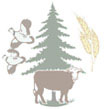Associated Press
Chestnut growers look to Missouri for crop's revival
Dec. 17, 2005
NEW FRANKLIN, Mo. - There's no catchy marketing slogan like the one that moved orange juice beyond the breakfast nook a generation ago. Their starchy taste is decidedly acquired, and difficult to describe. To make matters worse, their shell is hard to crack.
But a group of agricultural researchers at the University of Missouri-Columbia have a holiday message of their own for those who would confine them to the open fire roast: chestnuts aren't just for Christmas anymore.
"I don't think there's an image problem or a misperception," said Mike Gold, associate director of the university's Center for Agroforestry, where tree scientists are experimenting with more than 50 varieties of chestnuts at a Howard County research farm. "I think there's just a flat-out unfamiliarity."
A century ago - before an Asian blight devastated most of the country's millions of chestnut trees - no slogans were necessary. Chestnuts were a staple of American diets, particularly for recent immigrants. The trees' rot-resistant timber was used to build barns and beams, its bark providing tannin for leather.
While the chestnut remains a gastronomical oddity for most Americans, commercial production of a heartier, disease-resistant Chinese variety is increasing as growers struggle to keep up with demand.
"Usually, by the end of October all the chestnut growers start calling each other looking for chestnuts because we're all sold out," said Greg Miller, a commercial grower in Carrollton, Ohio.
With 32,000 pounds produced this year, Miller's Empire Chestnut Co. is one of the nation's largest operations outside California, where most growers cultivate a Japanese species. He's seen a steady growth in income the past 10 years and has harvested chestnuts full-time for the past two decades.
Still, domestic production is just a fraction of the global market, said Gold, who estimates that American chestnut growers produced 1.5 million pounds last year, compared to 200 million pounds worldwide.
A university-sponsored market survey earlier this year of 90 growers in 50 states showed that most producers generate less than $5,000 annually - with 35 percent yet to realize their first sale from trees that take up to 10 years to produce commercial amounts.
"There's room to greatly expand the market," Miller said. "But first we have to prime the pump."
Gold and his fellow devotees gladly accept that challenge, which they said starts with increased public recognition of chestnuts' benefits.
As a food source, the chestnut is high in fiber, antioxidants, vitamin C and unsaturated fatty acids, more akin to a grain, such as brown rice, than other nuts. Some call it the "un-nut."
As a crop, it's more profitable than walnuts and pecans, its closest rivals, with wholesale prices of $3 to $3.50 per pound compared to those other nuts, which fetch 80 cents to $1.40 per pound on average.
And as a seasonal symbol of the fall harvest, it deserves a place on the cultural mantle alongside pumpkins and maple syrup, said Gold. And not just in December, when oldies stations and shopping malls pull out Nat King Cole's or Perry Como's versions of "The Christmas Song."
"It tends to have an Old World sensibility," he said. "The song, linked to the holiday, creates an image. It means family."
While the notion of chestnut bisque, chestnut stuffed quail and other such dishes might make finicky eaters recoil, Gold said it wasn't long ago that Americans made similar observations about "exotic" avocados and kiwis.
Unlike the American chestnut trees that once dominated the Eastern seaboard, reaching heights of nearly 200 feet and 6 feet in diameter, the Chinese varieties cultivated at the university farm 30 miles northwest of Columbia produce optimum yields at a mere 17 feet tall.
In addition to an annual fall harvest festival, they plan to soon offer seminars for prospective chestnut growers, said Gold, who is also an associate professor of forestry at the University of Missouri-Columbia.
"Our focus is really on creating a new nut industry," he said.
--ALAN SCHER ZAGIER
Associated Press

